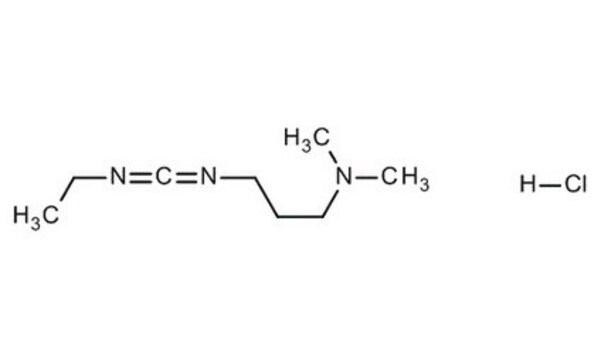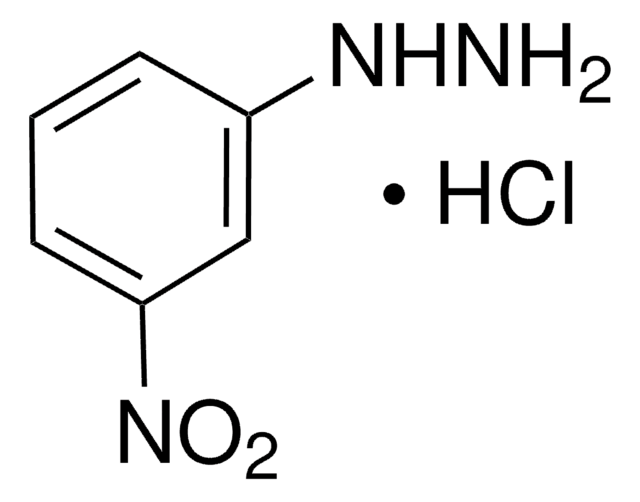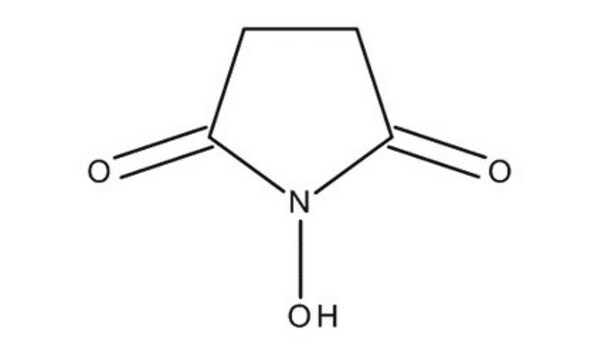Kluczowe dokumenty
03450
N-(3-Dimethylaminopropyl)-N′-ethylcarbodiimide hydrochloride
purum, ≥98.0% (AT)
Synonim(y):
N-Ethyl-N′-(3-dimethylaminopropyl)carbodiimide hydrochloride, EDAC, EDC, EDC hydrochloride, WSC hydrochloride
About This Item
Polecane produkty
klasa czystości
purum
Poziom jakości
Próba
≥98.0% (AT)
Formularz
powder
mp
110-115 °C (lit.)
110-115 °C
rozpuszczalność
H2O: soluble 1 gm/10 ml, clear to very slightly hazy, colorless to very faintly yellow
Zastosowanie
microbiology
temp. przechowywania
−20°C
ciąg SMILES
Cl.CCN=C=NCCCN(C)C
InChI
1S/C8H17N3.ClH/c1-4-9-8-10-6-5-7-11(2)3;/h4-7H2,1-3H3;1H
Klucz InChI
FPQQSJJWHUJYPU-UHFFFAOYSA-N
Szukasz podobnych produktów? Odwiedź Przewodnik dotyczący porównywania produktów
Opis ogólny
The adaptability of EDAC HCl encompasses nucleic acid modification, permitting the selective labeling of DNA and RNA through their 5′ phosphate groups. This capacity contributes significantly to the visualization, tracking, and analytical aspects of these fundamental molecules, thereby advancing nucleic acid research. Furthermore, EDAC HCl functions as a biomolecule bridge, acting as a crosslinker connecting amine-reactive NHS-esters of biomolecules to carboxyl groups.
This feature proves invaluable in protein conjugation, facilitating the development of hybrid molecules with distinct properties and functions. The underlying reaction mechanism involves EDAC HCl′s interaction with a carboxyl group, forming an unstable intermediate actively seeking an amine partner. The delicate equilibrium of this reaction underscores the necessity for optimizing conditions to ensure efficient conjugation. The assistance of N-hydroxysuccinimide (NHS) enhances the capabilities of EDAC HCl by stabilizing the intermediate and enabling two-step conjugation procedures, affording greater flexibility and control, particularly in the manipulation of complex biomolecular structures.
Zastosowanie
Działania biochem./fizjol.
Cechy i korzyści
Inne uwagi
produkt podobny
Hasło ostrzegawcze
Danger
Zwroty wskazujące rodzaj zagrożenia
Zwroty wskazujące środki ostrożności
Klasyfikacja zagrożeń
Acute Tox. 3 Dermal - Acute Tox. 4 Oral - Aquatic Acute 1 - Aquatic Chronic 1 - Skin Irrit. 2 - Skin Sens. 1 - STOT RE 2 Oral
Organy docelowe
Stomach,large intestine,lymph node
Kod klasy składowania
6.1C - Combustible acute toxic Cat.3 / toxic compounds or compounds which causing chronic effects
Klasa zagrożenia wodnego (WGK)
WGK 3
Temperatura zapłonu (°F)
Not applicable
Temperatura zapłonu (°C)
Not applicable
Środki ochrony indywidualnej
dust mask type N95 (US), Eyeshields, Gloves
Wybierz jedną z najnowszych wersji:
Masz już ten produkt?
Dokumenty związane z niedawno zakupionymi produktami zostały zamieszczone w Bibliotece dokumentów.
Klienci oglądali również te produkty
Produkty
Carbodiimide-mediated peptide coupling remains to the most frequently used technique.
Nasz zespół naukowców ma doświadczenie we wszystkich obszarach badań, w tym w naukach przyrodniczych, materiałoznawstwie, syntezie chemicznej, chromatografii, analityce i wielu innych dziedzinach.
Skontaktuj się z zespołem ds. pomocy technicznej











